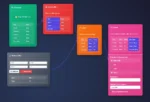In today’s rapidly evolving data landscape, even the most robust data processing pipelines occasionally encounter failures. Missing or lost data can pose a significant threat to operational efficiency, strategic analytics, and ultimately, competitive advantage. Implementing a Dead Letter Queue (DLQ) represents a fundamental yet powerful strategy for handling such inevitable errors gracefully. This not only safeguards valuable information but also enhances the reliability of your analytics processes, empowering you to turn previously frustrating data failures into strategic opportunities. Whether you’re managing real-time stream processing or complex batch workflows, a properly structured DLQ implementation can drastically improve your data resilience and analytics outcomes. Let’s delve into the essentials of DLQs, their application, and how your organization can harness their power to unlock improved analytics performance and innovation-driven growth.
What is a Dead Letter Queue and Why It Matters
A Dead Letter Queue is essentially a specialized storage mechanism that captures messages or data payloads that fail to process correctly within your data workflows. Think of it as the analytics pipeline’s safety net, where troublesome or malformed data points end up rather than simply disappearing or causing system disruptions. With today’s analytics-driven organizations processing massive volumes of data, ensuring the integrity and completeness of this data is not only mission-critical—it is central to maintaining trusted analytical insights and decisions.
DLQs matter because they bridge the gap between flawless data streams and the inevitable errors of real-world data processes. By implementing an effective DLQ, organizations can isolate problematic data, diagnose underlying problems efficiently, and thereby significantly minimize downtime and improve overall operational efficiency. Not only does this strengthen internal process reliability, it further amplifies the value of your investment in advanced analytics capabilities.
Without a DLQ, organizations risk losing crucial data or generating misleading analytical outcomes. On the contrary, leveraging DLQs supports a more robust data foundation—a principle that successful businesses increasingly rely upon. As data strategists often highlight, good data-driven decision-making starts with quality data management practices. For further context, explore our insights on uncovering hidden opportunities through data analytics to gain perspective on why stringent data processing practices truly matter to sustained business growth.
Identifying When and How to Implement Dead Letter Queues
Implementing a Dead Letter Queue should become a priority the moment your organization recognizes recurring errors within your existing data pipelines. Indicators can include intermittent processing breakdowns, data discrepancies, or unanticipated metadata changes. Often, entities with high-throughput data streams ranging from event-driven architectures to automated analytics ingestion pipelines find DLQs critically important, especially when data sources or processing frameworks frequently encounter inconsistent schemas or external interruptions.
Successful implementation hinges on several factors. Initially, it’s essential to thoroughly audit existing data workflows to clearly pinpoint your pipeline’s failure points and ensure visibility of missed messages. Next, define appropriate criteria or business rules for classifying and identifying failed data. Establishing clear thresholds and strategies for retry mechanisms avoids overwhelming your DLQ and ensures that failed data is isolated according to precise business logic. Also, consider the scalability of your queueing resources—DLQs should operate without bottlenecks, supporting proportional growth in data volume and complexity over time.
As you’re laying out your dead letter handling processes, aim to make them accessible for ongoing analytics and monitoring. Maintain clear visibility to the DLQ’s status, enabling data scientists and analytics teams to assess impacts, troubleshoot issues, and leverage this insight toward continuously improving overall analytics accuracy. Need a deeper discussion on implementing advanced analytics frameworks? Check out our advanced analytics consulting services for expert assistance tailored specifically to your team’s analytical objectives and infrastructure.
Choosing the Right Architecture for Your Dead Letter Queue
A correctly structured DLQ greatly depends on your current technology-stack, processing methodologies, and analytics demands. Organizations using cloud-intensive data analytics might prefer dedicated managed DLQ services integrated seamlessly within cloud providers, such as AWS SQS or Google Pub/Sub. Alternatively, your infrastructure may call for an open-source solution that allows greater flexibility and control, such as Apache Kafka Dead Letter topics or RabbitMQ.
The architecture choice should align directly with your organizational context—considering data scale, message durability, the strengths of current team skills, and pre-existing data pipelines. For example, those handling smaller batch processes requiring straightforward implementable solutions may choose simpler tools, while organizations running large-scale real-time analytics streams could require sophisticated architectures with integrated failure analytics.
Also, factor in compatibility with current environments, frameworks, and analytics tools. Integrating a DLQ effectively necessitates a careful approach aiming to minimize disruptions or overhead. Teams utilizing Node.js might find value in our detailed guide: how to send XML data to Google BigQuery using Node.js, demonstrating a significant practical experience that aligns with effective DLQ implementations as part of different technology stacks.
Ultimately, choosing the correct DLQ architecture is about striking an optimal balance between reliability, ease of use, compatibility, scalability, and cost efficiency. The wrong architecture choice could compromise your analytics capabilities, induce undue complexity, or incur unnecessary performance overhead—so investing time and resources into making informed decisions can pay huge dividends in improving analytics resilience.
Best Practices for Managing and Monitoring Dead Letter Queues
To fully realize the value of DLQs, robust management and proactive monitoring are crucial. Regular monitoring should include metrics such as DLQ depth, entry frequency, or processing latency. Real-time alerts addressing unusual activity, spikes in rejected messages, or unexpected growth of queue volumes should also be built to maintain proactive control and resolution.
An essential best practice is to routinely perform detailed analytics and diagnostic studies on the data ending up in the DLQ. This practice clarifies root causes, systemic issues, and enables continuous improvement of data architectures and processes. By implementing sound logging practices and embedding searchable metadata with clear indicators of problematic data, analytics and engineering teams significantly boost productivity and troubleshooting efficiency.
Furthermore, DLQ management implies thoughtfully designed retry mechanisms integrated with fallback handling or escalating prioritization systems. Understanding when and how often to reprocess dead-lettered messages is critical in balancing process effectiveness, analytics reliability, and resource availability.
At Dev3lop, we have gathered considerable experience helping businesses adopt robust analytics management practices. For detailed guidance on finding your footing in the rapidly changing data landscape, consider visiting our article on how to break into the data industry effectively. Embracing DLQ best practices not only safeguards your data but also positions your analytics team to deliver consistently precise and insightful results.
Using Insights from Your Dead Letter Queue to Improve Your Data Visualization and Analytics Strategy
Beyond their primary usage—error notification and message buffering—dead-letter queues offer strategic advantages by acting as an analytical goldmine. Recognizing patterns of data failure and aligning these insights to analytics visualization practices can drastically enhance reliability, credibility, and strategic comprehension across your analytical processes.
Integrating DLQ insights into analytics strategy means diagnosing frequent discrepancies or misunderstanding in data processing logics and metrics early on. As you refine analytics processes and evolve towards optimized data visualizations, integrating these insights becomes indispensable. Drawing correlations between dead-letter analytics and front-end data visualization inaccuracies will provide timely diagnostics, enhancing both prevention and proactive analytics governance.
Clear and effective visual analytics serve as the cornerstone of strategic decision-making proficiency. To deepen your capabilities leveraging visualization and communicating these complex insights effectively, consider referencing our article: guide to creating visually appealing data visualizations.
Ultimately, data strategists consider every data artifact—successful or unsuccessful—as providing immense value for optimizing insights and outcomes. Leveraging Dead Letter Queues strategically allows you to harness previously unexplored opportunities, fueling innovation and analytical excellence across your organization.
Conclusion
Implementing Dead Letter Queues exemplifies strategic foresight in data processing and analytics management—shifting data failures from disruptive nuisances to insightful opportunities. By selecting fitting architectures, embedding rigorous monitoring processes, and linking analytic insights proactively, organizations continuously fortify their data reliability. Explore some deeper strategic insights like our perspective on why stream processing matters over traditional batch models for greater clarity within the evolving data industry.
Need to accelerate your analytics transformation journey? Connect with experts dedicated to your analytics success.



















